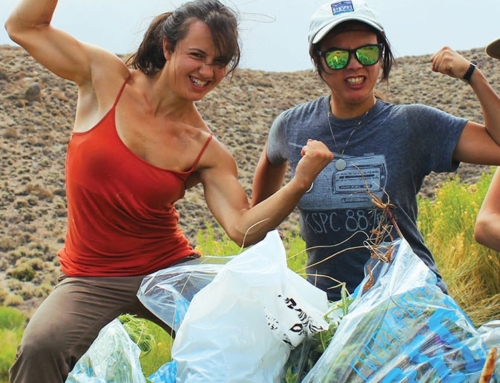Spring is well on its way here in the Eastern Sierra and that means the start of our field season! Eastern Sierra Land Trust staff and partners are looking forward to taking our work outside, teaming up with volunteers, and helping restore important habitat for local wildlife.

Last year, volunteers Randy (left) and Bob (right) helped protect native plant seedlings growing in the Round Fire burn area by covering them with mesh cages.
And the first place we’ll be heading? Right where Eastern Sierra Land Trust’s conservation work began more than 15 years ago: in the Round Valley mule deer herd’s migration corridor.
Join us on Tuesday, 4/18, and then again on Tuesday, 5/2 as we team up with volunteers in our community to restore the important mule deer habitat that was damaged in 2015’s Round Fire!
Round Fire Volunteer Restoration Workdays
Tuesday, April 18 and Tuesday, May 2
9 am – 12 pm
RSVP to for directions
Protecting an Important Migration Route for Local Wildlife
Twice a year the Round Valley mule deer herd travels between its winter range on the valley floor and the high meadows of the Central Sierra. As the deer search for nutritious forage, they keep to the same trails they have followed for millennia.
As human presence has increased, the Round Valley deer have faced new obstacles along this route. In addition to the constant danger posed by vehicles, development has hampered portions of the deer’s limited habitat making finding food and shelter more difficult. Since 2001, Eastern Sierra Land Trust has worked with families living in the area who want to ensure that the deer will have a safe route to travel for generations to come.
In February 2015, the region was hit hard by the Round Fire and much of the deer’s habitat in that area was damaged or destroyed. Since then, we have been working with volunteers, local agencies, and residents to ensure that native plants regrow, and to prevent invasive weeds from gaining a foothold.

ESLT staff members Susanna Danner and Sara Kokkelenberg were in the area last week, and they are happy to report that the recovering landscape is looking healthy. They saw at least seven mule deer, fence lizards, wrens, a Say’s phoebe, gophers, ground squirrels, native bees, and the fresh leftovers of a coyote’s breakfast.
Native bunch grasses are abundant, and many of the bitterbrush seedlings that volunteers caged last spring with protective mesh have already outgrown their cages. They also documented cacti, wild onion, sagebrush, rabbitbrush, Ephedra, willow, desert ceanothus, xeric fungi, and other native vegetation rooted strongly in the ground.
Weeds such as Russian thistle have not yet sprouted in the burn area, so it’s easy to be tricked into thinking that they have somehow vanished over winter. Not so we still have work to do!
Take Action: You Can Make a Difference
By joining our volunteer team, you can help make sure that this important home for wildlife continues to regrow and thrive.
Our main goal during volunteer restoration days this springwill be to plant bitterbrush seedlings, and protect naturally-existing seedlings with mesh cages. When established, these native plants will provide mule deer with important nutrients that they need along their annual migration.
Volunteers should wear appropriate clothing for outside work, including closed-toe shoes, long pants, and a hat. Please bring water and leave pets at home. To learn more and sign up to participate, please contact Indigo Johnson, ESLT Education Coordinator / AmeriCorps Member,at (760)873-4554 or email !










[…] volunteer-driven stewardship events on our protected […]